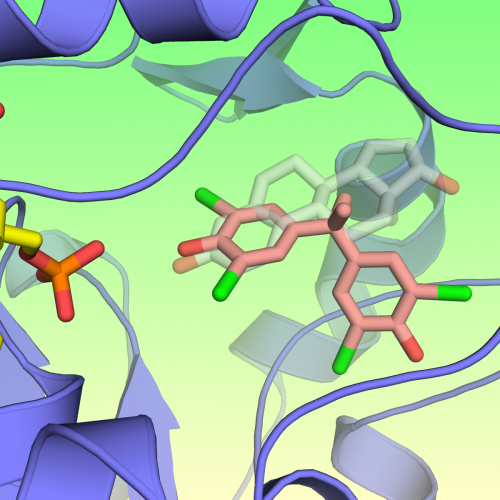3-D images show flame retardants can mimic estrogens

By determining the three-dimensional structure of proteins at the atomic level, researchers at the National Institutes of Health have discovered how some commonly used flame retardants, called brominated flame retardants (BFRs), can mimic estrogen hormones and possibly disrupt the body's endocrine system. BFRs are chemicals added or applied to materials to slow or prevent the start or growth of fire.
"We're beginning to have a better understanding of flame retardants and their effect on human health. This particular study helps us literally see what brominated flame retardants do when they get in the body—they interfere with the body's natural hormones," said Linda Birnbaum, Ph.D., director of the National Institute of Environmental Health Sciences (NIEHS), part of NIH, and National Toxicology Program (NTP). "Using the 3-D imaging capabilities, we can see the flame retardants binding, or attaching, to proteins like estrogens do."
Birnbaum is an author on the new study which appears online in Environmental Health Perspectives. She and her fellow researchers conducted the study in a facility jointly supported by several NIH institutes.
Birnbaum, a leading researcher on flame retardants, joined with biologists and a postdoctoral fellow to look more closely at one of the most widely used BFRs, tetrabromobisphenol A (TBBPA). Earlier this year, NTP released data from a two-year bioassay study, showing that TBBPA caused tumors in rats and mice.
"Having chemicals act like estrogen or other hormones disrupts how the endocrine system works," said Birnbaum. "In this case, the ability of flame retardants to bind to and inhibit an enzyme that metabolizes estrogen, called estrogen sulfotransferase, could result in the body having too much estrogen."
The endocrine system is one of the body's main communication networks and is responsible for controlling and coordinating numerous functions, including growth and development, reproduction, response to stress, and energy levels.
There are hundreds of different flame retardants. They are often broken into categories based on chemical structure and properties. BFRs, such as TBBPA, are used in many types of consumer goods, including electronics, furniture, building materials, and automobiles. Flame retardants are being studied, because of their pervasiveness and concerns about possible adverse effects on the endocrine, immune, reproductive, and nervous systems.
For this study, the researchers used X-ray crystallography to build a 3-D model of the protein binding to flame retardants. Crystallography allows researchers to look at proteins at the atomic level. They examined how TBBPA and a metabolite, or derivative, of another flame retardant called tetrabromodiphenyl ether, or BDE-47, compared with binding of estradiol, a naturally occurring estrogen, to the estrogen sulfotransferase.
Although many flame retardants, including BDE-47, are no longer produced in the United States, some BFRs are slow to break down and can persist in the environment. People can be exposed to flame retardants through a variety of ways, including diet; consumer products in the home, car, and workplace; and house dust.
"Using crystallography allows us to visualize exactly how these compounds can interact with the body's enzymes," said Lars Pedersen, Ph.D., Collaborative X-ray Crystallography Group leader at NIEHS. "Our results revealed TBBPA binding to the estrogen sulfotransferase at the same position and in a similar manner as estradiol binds."
"Although there is much more to be learned about how these chemicals and their metabolites impact different systems in the body, every piece of the puzzle helps increase our understanding of the effects they may have." Researchers, like Pedersen and Birnbaum, hope the findings will be used by companies to develop safer alternatives to current flame retardants.
More information: Gosavi RA, Knudsen GA, Birnbaum, LS, Pedersen LC. Mimicking of estradiol binding by flame retardants and their metabolites: a crystallographic analysis. Environ Health Perspect; DOI: 10.1289/ehp.1306902 [online August 19, 2013]
National Toxicology Program. 2013. Tetrabromobisphenol A. Available: ntp.niehs.nih.gov/go/TS-M200033 [accessed August 12, 2013].
Journal information: Environmental Health Perspectives
Provided by National Institutes of Health
















